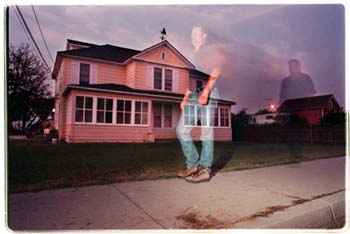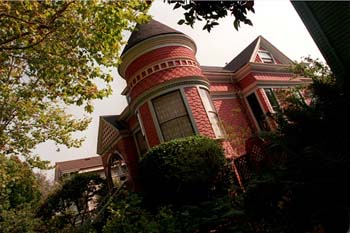![[Metroactive Features]](/features/gifs/feat468.gif)
[ Features Index | San Jose | Metroactive Central | Archives ]
 George Sakkestad Ghosts In Our Machine Once merely the stuff of urban legend, today's ghost stories are getting the attention of experts within real science--not to mention real estate By J. Douglas Allen-Taylor Are there ghosts in Silicon Valley? That seems such a retro question in these high-tech days. Silicon Valley is the very definition of science and technology, a place of reason where all phenomena are explainable and can be reduced to either a website link or a subheading in a technical manual. Ghosts seem archaic, a part of our grandparents' time, old stories with which to scare foolish children. And yet the valley is an ancient place, far older than the gleaming campuses and spreading subdivisions and concrete highway ribbons we have laid down over it. Who knows what secrets are buried beneath us? Perhaps the things that wait in the dark just beyond the range of our sight have not vanished at all, but are only biding their time, spinning their deep webs, lurking, preparing to pounce on us when we are most unaware. Perhaps there are still ghosts in Silicon Valley. Some people certainly believe there are. Energetic Explanation SOME SERIOUS students of the paranormal give a science-based explanation for the phenomenon: energy. Holistic health practitioner Melinda Connor, who up until a year ago was based in the South Bay, says that what people call haunted houses can actually be one of three very different energy forms. She describes the first form as a sort of memory of an event that can remain with the physical objects in a room or a house, particularly after an especially traumatic event. "The energy wave, basically, gets stuck. The environment has a memory, and replays it. For example, you can have somebody die in a room and a lot of people got frantic around it, or the person struggled at the end. Then the energy of that death can get stuck in the walls or in the table or in the carpet. And, of course, you can feel it." Connor says the next level of energetic attachment in a house is what people commonly call a ghost: the conscious, disembodied spirit of a dead person. "Sometimes, when people die, they're confused. They don't know where to go and they don't know quite what to do. They're stuck in transition, and they hang around in a particular location, trying to find the way out. Or it's a person who wants to enact a particular form of revenge. Or it's a person who is sticking around to learn something. You can also have ghosts with a mission, like protecting women." She says that the third, and highest, energy--which takes over an entire house--is the most frightening. "Structures can be attached by what you call energies in distortion. You get negative thought forms which are fed by a single person or by a collective group of people or by groups of people over centuries which take on an energy form and gradually take on a consciousness." This form of energy "is not human," Connor says. "It has never been human. It's a very primitive consciousness, ordinarily. Usually it functions out of a single thought form, like, 'I'm hungry,' or 'I'm in terror.' I call them critters. They generally look like crabs with extra legs or an extra half a body. A heart with extra chambers. This energy in distortion wants to create a certain kind of rhythm so it can get fed. It's fed by fear. Or terror. Or anguish. It creates a distortion in whatever it's attached to so that the people will come into that area and feel that emotion so the energy form gets fed. And so you start to identify that area with that kind of emotion." And, of course, get scared to death.
AUTHOR Katherine Ramsland does not sound at all like someone who specializes in studying the dark, scary side of the human psyche. Her conversation is broken constantly by a light, gentle laughter, the sound of bells tinkling, the way one imagines elves must laugh. Yet the Rutgers-trained psychologist has explored the eerie underworld of the American vampire subculture in a book titled Piercing the Darkness, and for the past year she has been working on a book that seeks to shed light on ghosts and the world of people who try to chase them down and prove their existence. To do so Ramsland has become something of a ghost hunter herself, trolling through old graveyards and haunted houses and historic battlefields from Princeton to Gettysburg with a wide array of the tools of the ghost hunters' trade--digital cameras, camcorders, voice-activated tape recorders, electromagnetic field detectors, thermal scanners, night vision goggles with infrared lighting, motion detectors--all in an effort to see if there is something in the world beyond that can be considered "ghosts." "I call the things that I have encountered 'energy anomalies,' " she says. "The ghost hunters will take the big leap and say that these are spirits of the dead. I don't know. I'm just trying to link what I'm getting in my own experience to research that has been done by credible sources. I'm trying to fill in the gaps." Some of the phenomena encountered by Ramsland are difficult to explain away in scientific terms. Once, in a cemetery in Lancaster, Pa., she recorded a voice that could only be heard on audiotape, saying, "Why are you doing this to us?" Another time, a tour guide took her to the basement of the Lizzie Borden House in Fall River, Mass., the house where Lizzie was supposed to have hacked her parents to death with an ax more than 100 years ago. "I turned on the recorder and I said, 'Is anyone here with us?' We waited in silence. About 20 seconds, I guess. Then I rewound the tape and played it back. And you could hear me say, 'Is anyone here with us?' and then a voice answering, 'YES!' We ran up the steps." Ramsland says there are many scientists working on the phenomenon of detecting ghosts, and hosts of individuals who are trying to detect them. "I've gone to psychics and mediums. I've had seances." Some she dismisses as charlatans, but some people she has met during her yearlong study she considers sincere and dedicated, including Dave Oester and Sharon Gill of the Oregon-based International Ghost Hunters organization (http://www.ghostweb.com/index.html), from which she received an official ghost hunter certification. CABRILLO College psychology professor Andy Neher has been called a ghost debunker, but he's not very fond of the term. He can be compared to Harry Houdini, the illusionist who exposed hundreds of fake spiritualists as he attempted, in vain, to contact the ghost of his deceased mother. Neher has often been consulted by people who wish to prove or disprove the paranormal. "I'm curious about phenomena that seem to go beyond our everyday experience," Neher says. "I'm interested in them no matter what the explanation turns out to be. If it turns out to be something paranormal, that's fine. As a matter of fact that's even preferable because then we'd learn something new. So far I haven't run into anything truly paranormal. But I keep looking." Neher says that when people report ghost sightings or other paranormal activity, they could easily be telling the truth about having experienced something, but mistaken about their interpretation of the cause. In the case of reports of ghosts moving furniture or other items in a house, for example, "I think it usually turns out to be a case of one member of the family playing tricks on the rest of the family. They can do it by a number of means. Thread that's hard to see that they can tug on that's connected to something that moves. Something like that." According to Neher, reports of being touched by a spirit are more likely to be hallucinations rather than actual physical contact. "There are certain mental states in which people can experience strange feelings," he says. "For example, before you wake up fully in the morning you go through what's called a hypnopompic period. For some people it's a period when they are still having dreamlike imagery but their body is in stage-one sleep, that is, the lightest stage of sleep when we dream. Our bodies are paralyzed except for our eyes. These people sometimes have these imagery experiences and because they're in this kind of twilight zone they don't know how to interpret it. They think it could be ghosts. Could be ETs. Could be out-of-body experience. Interpretations just go on and on. But it's just an interpretation, of course. If there was nothing else besides thinking your hair was being played with or whatever, then how do you know what is doing it?" He says that phenomena such as ghost voices on a tape recorder can be nothing more than the common psychological process called "projection." "That is the process by which you hear something vague and, because you have a mindset to interpret it in a certain way, you interpret it in that way, whereas someone else with a different mindset may not interpret it at all in the same way." Neher notes that Latvian-born psychologist Konstantin Raudive, publisher of a book called Breakthrough, did this kind of thing 25 years or more ago. First Raudive would let the tape recorder run without recording any particular sounds. "Then he would listen to these tapes and he would hear various things that he interpreted as voices saying things," Neder explains. "The problem was that other people listening to the tapes just heard noise. These types of things are subject to interpretation, and if you listen to them long enough you can probably hear just about anything you want. That's projection." But Neher hastened to add that his explanations were no more than interpretations themselves, just guesses. "The question is not whether or not these people have had the experience they claim. The question is their interpretation, their intellectualization of the experience as being the only explanation. They may be right. But if it's not the only explanation, then they may not be right." [ San Jose | Metroactive Central | Archives ]
|
From the October 28-November 3, 1999 issue of Metro, Silicon Valley's Weekly Newspaper.
Copyright © 1999 Metro Publishing Inc. Metroactive is affiliated with the Boulevards Network.
For more information about the San Jose/Silicon Valley area, visit sanjose.com.
